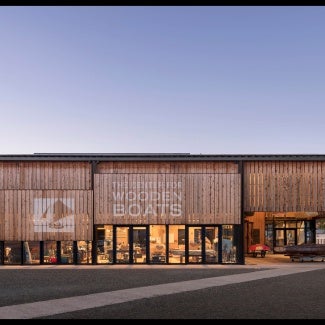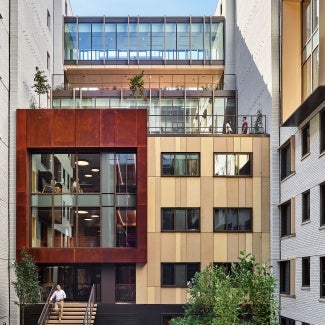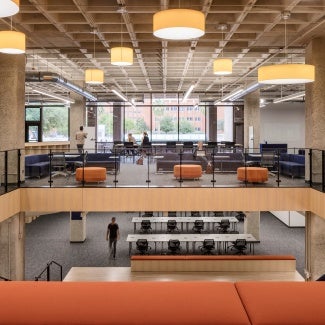University of Washington, Life Sciences Building
The award-winning contemporary architecture of the University of Washington, Life Sciences Building creates a new next-level facility—allowing the biology department to transform how it teaches and conducts research.

Project highlights: University of Washington, Life Sciences Building
- Architect: Perkins&Will
- Owner: University of Washington
- Location: Seattle
Nature and technology converge at the University of Washington’s Life Sciences Building, a 207,000-square-foot facility that houses 40 principal investigators and their teams in a healthy and collaborative environment. The building replaces two antiquated facilities, allowing the biology department’s faculty to transform how it conducts research and how it teaches the subject to a rapidly growing student population.
Ranging from molecules to ecosystems, biology is an extremely varied science, one that also hinges on collaboration and is technically power intensive. The building is designed to meet its users’ power, temperature, and humidity control demands while fostering collaboration in an environment where undergraduate research mimics science itself.
This next-level facility creates an ecotone, a term for the transitional region between two biological communities, in its program and design, where the technology behind the science of biology intersects with the study of our natural world. Its southern exterior is composed of metal, glass, and energy-generating solar fins that represent advances in technology, while its northern exterior encompasses natural wood and visual connections to a treasured deodar cedar tree canopy lining the campus’ woodland paths. They converge at a six-story, 1,000-square-foot glass atrium that connects both ends.
Core concepts that drove the project resulted in teaching and research spaces that are flexible and efficient, and ample informal interaction spaces are scattered throughout the building. The design was able to accommodate 18 more principal investigators than originally planned, and the building’s labs, offices, and conference rooms boast natural light and outdoor vistas. A feature stair with oversized landings that encourage unprompted encounters between scientists and students hangs in the glass atrium. The high-tech glass system surrounding the stair seems to disappear as users look out onto a public courtyard, one of the campus’ primary thoroughfares.
Displaying the new building’s sustainability and making it a part of the school’s education efforts was another project goal. Its greenhouse research space and renowned plant collection are just steps away from a pedestrian trail, while other unique plants from biology courses were integrated into the landscape that cascades from the building’s west entrance. The nearly 500 photovoltaic fins on the southwest facade serve as a constant reminder of sustainable innovation, feeding real-time data to dashboards in the lobby that invite students to compare it to the energy generated by standard solar panels on the roof.
Since opening, the Life Sciences Building has helped the university meet growing demand for the largest department on campus and the largest STEM program in Washington. Students were intimately involved in the design process, partnering with the design team on its solar innovations and grant funding. They remained involved during the design and construction phases, solidifying an engagement that has continued after the project’s completion.
Project team & Jury
Architect: Perkins&Will
Project Team: Anthony Gianopoulos (Managing Principal), Andy Clinch (Project Manager/Designer), Devin Kleiner (Project Architect), Shanni Hanein (Job Captain)
Client Team: Major Capital Projects; College of Arts and Sciences; Department of Biology; Office of University Architect
General Contractor: Skanska USA
Mechanical Contractor: McKinstry
Electrical Contractor: VECA Electric
Landscape Architect: Gustafson Guthrie Nichol
Structural and Civil Engineer: Coughlin Porter Lundeen
Mechanical and Electrical Engineer: Affiliated Engineers, Inc.
Lighting Design: Blanca Lighting
Ashley Wilson, FAIA, Chair, Ashley Wilson Architect, Alexandria, Va.
Jose Leo Arango, Assoc. AIA, EYP, District of Columbia
Randall Deutsch, FAIA, University of Illinois at Urbana-Champaign School of Architecture, Champaign, Ill.
Gabriel Ignacio Dziekiewicz, AIA, DesignBridge, Chicago
Teresa Jan, AIA, Multistudio, San Francisco
Luis Nieves-Ruiz, East Central Florida, Regional Planning Council, Orlando, Fla.
Zakiya Wiggins, AIA, LS3P, Raleigh, N.C.
The 2023 Architecture program celebrates the best contemporary architecture regardless of budget, size, style, or type. These stunning projects show the world the range of outstanding work architects create and highlight the many ways buildings and spaces can improve our lives.
Sixteen projects showcase the best contemporary architecture.







